7 Best Shooting Ear Protection to Save Your Hearing [2024 Guide]
 Bryan Hill / March 21 2024
Bryan Hill / March 21 2024
Guns are LOUD. The bigger, the louder.
But even the smallest guns can cause hearing loss. Even more indoors.
And you can still damage your hearing while wearing ear protection! They're not made equal.
When you suffer hearing loss, you don't get it back.
How much is your hearing worth to you?
Read on to find:
On this Page:
- Decibels (dB) vs. Noise Reduction Rating (NRR)
- Electronic vs. Passive Earpro
- Earmuffs vs. Earplugs
- Earpro in Practice
- 7 Best Hearing Protection for Shooting
- References
Decibels (dB) vs. Noise Reduction Rating (NRR)
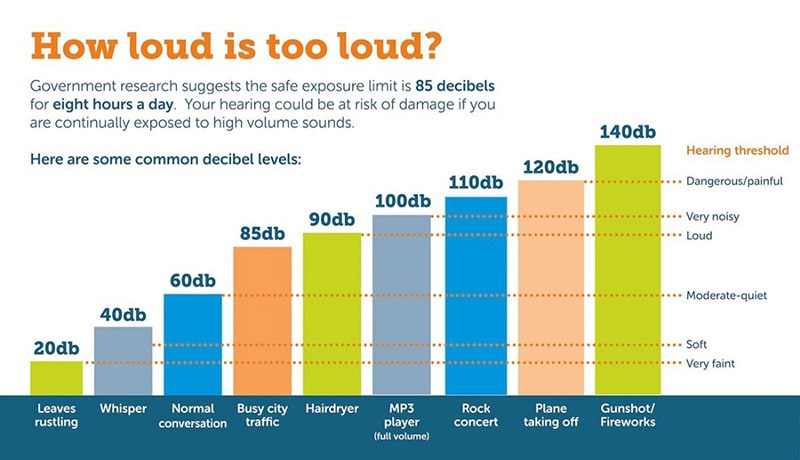 Image from Hearinglink.org.
Image from Hearinglink.org.
Decibels (dB) is a measurement of sound.
It scales in a weird way: Increase dB by 3 (from 10 to 13, 13 to 16, etc.), and it doubles the power from the source.
Sound creates a pressure wave in the air, and that's measured as Sound Pressure Level (SPL).
When that pressure wave hits your ear, you hear the sound.
For every 6 dB added to the SPL, the perceived loudness doubles.
Let's say you have a sound at 100 dB. It takes 4x the power to increase it to 106 dB, but the sound will only be 2x as loud as before when it reaches your ear.
Sounds louder than 120 dB can cause immediate hearing loss.
[1]
Pistol shots are around 163 dB.
[2]
Earpro has a
noise reduction rating (NRR): how much it reduces dB. More is better.
If a gunshot went off right by you at 163 dB, but you were wearing NRR 43 earpro, your ears would get 120 dB of sound.
No immediate hearing loss.
However, that protection makes everything harder to hear.
Maybe a friend or instructor is trying to tell you something.
Or, someone is sneaking up on you.
[3]
[4]
[5]
[6]
How do we protect our hearing while hearing important stuff like that?
Electronic vs. Passive Earpro
Electronic
Electronic earpro uses microphones to pick up sounds around you.
You set the volume, like listening to music on headphones.
What happens when a gunshot goes off? It depends on the type of speakers:
-
Cutoff speakers: Loud noise cuts the speakers until noise levels get safe.
-
Compressor speakers: Loud noise gets adjusted to safe levels. Other sounds are unaffected.
Electronic earpro always has volume controls, microphones, and wires:
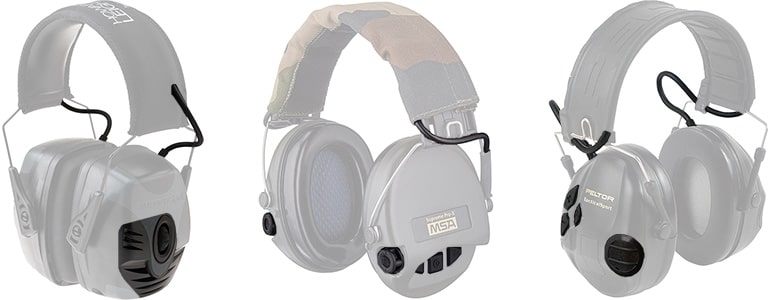
The best electronic earpro tells you where sounds come from, like a surround sound system.
[7]
[8]
Passive
Passive earpro just muffles all sounds. It has a smooth shell. No wires or switches:
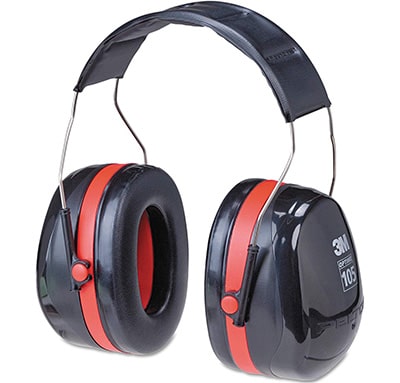
They save money:
-
Passive earmuffs, NRR 30: $20
-
Electronic earmuffs, NRR 30: $55 and up
Which is Better?
Get electronic earpro for:
-
Situational awareness when you shoot
-
Hear people talking when you shoot
Get passive earpro for:
-
Cheapest earpro
-
Most protection
-
Don't need to hear people speaking, or sneaking up on you
If the right choice seems clear, there's still something else:
How big do you want your earpro to be?
Earmuffs vs. Earplugs
Earplugs
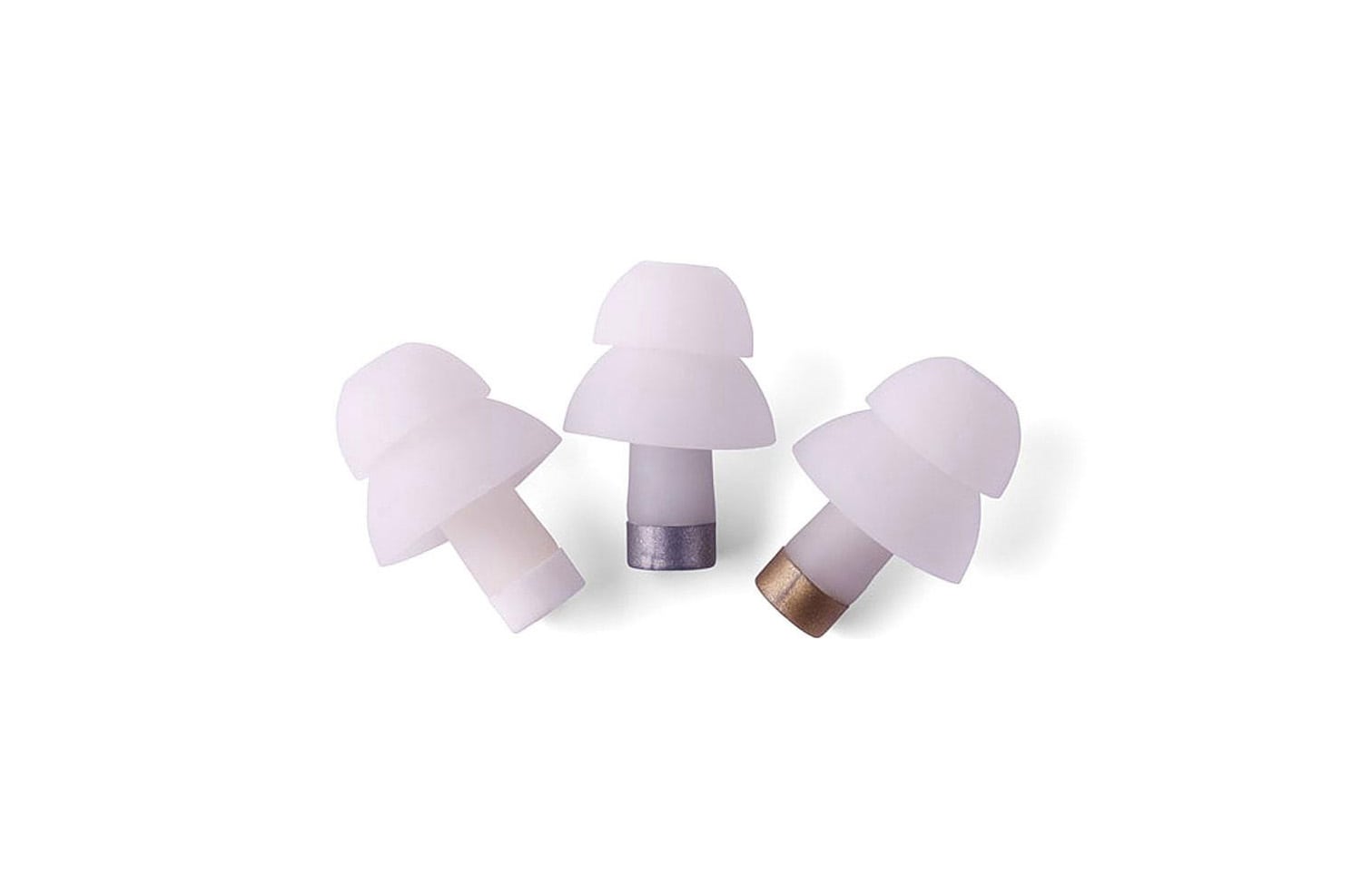
Earplugs fit inside your ear. They're cheap and convenient.
You might be thinking of the cheap, disposable earplugs.
They're great as a backup, but they kill sound quality.
If someone's talking to you, they'll be hard to understand, even if they yell.
High-fidelity earplugs let you enjoy a concert and protect your hearing.
They're non-disposable and retain high sound quality.
For shooting, they'll protect you and let you understand speech.
That comes in handy at training classes, or if you want a better range experience with friends.
Earmuffs
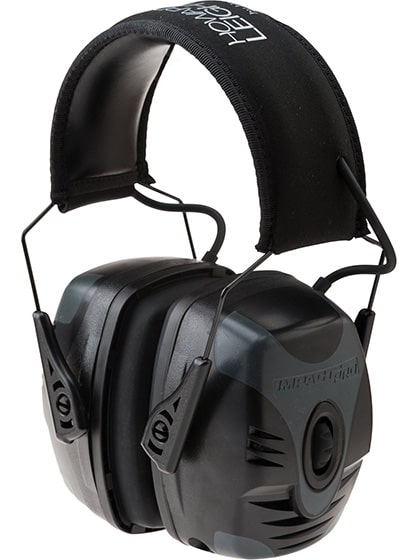
Earmuffs are like headphones. They're bulky, and more expensive than earplugs.
But that bulk has a good side:
-
Passive earmuffs protect your ears more.
-
Electronic earmuffs have better sound quality.
-
Electronic earmuffs give better situational awareness.
Our Solution
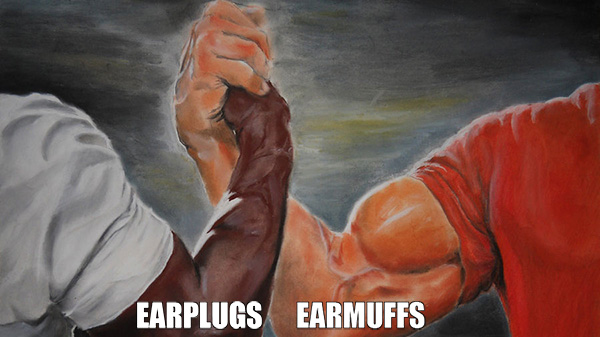
Double up: Wear
passive earplugs under
electronic earmuffs. Why?
-
Passive earplugs are convenient and cheap.
-
High-fidelity passive earplugs retain sound quality.
-
You can turn up the volume on electronic earmuffs and still hear everything.
-
You can be in a training class or long range day without losing hearing.
There are a few things to be aware of, though.
When Doubling Up, the Total NRR Isn't What You'd Expect
Some recommend taking the most protective of the two and adding 5.
[9]
But experiments show that doubling up results in 85-95% of the combined NRR, or 12-20 NRR of extra protection.
[10]
[11]
Other experiments had NRR increases of 2-13, 2-14, 3-14, 3-17, and 7-17, depending on the earplugs and muffs.
[12]
So if you had 30 NRR muffs with 20 NRR earplugs, the conventional wisdom is to expect 35 NRR.
What you can really expect based on experiments (and modern gear) is 42-47 NRR.
Why is this? Sounds come in different frequencies, like treble vs. bass.
NRR takes the average of protection across all those frequencies. An example:
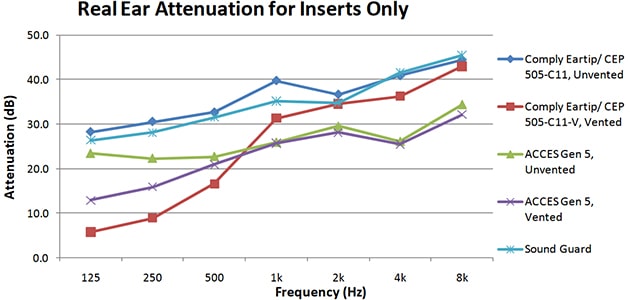
Most gunfire is loudest at 500Hz, and remains high through 8,000 Hz.
[13]
[14]
Human speech is 85-255 Hz.
If either muffs or plugs block a frequency really well, more protection won't help much.
If both muffs and plugs are weak against a frequency, their combined NRR won't be much better against that.
But if one covers the other's weakness, you gain NRR at the high end.
This is why the experiments cited above had NRR improvements of 2-20 dB from doubling up.
The ones where doubling up added only 2 NRR was when both plugs and muffs were strong OR weak.
But when one was strong and the other weak, then it was 13-20 NRR of gains.
Limits of Doubling Up
Even with the best muffs and plugs, you can't go above a total of 40-50 NRR. Why?
Most sounds travel through the air and into our ears.
But extremely loud sounds can travel through our bones to reach inside our ears.
[15]
[16]
Ever felt a sound so loud you could feel it in your chest? Earpro can't help you as much there.
You'd need a helmet or full body suit to protect your hearing.
Earpro in Practice
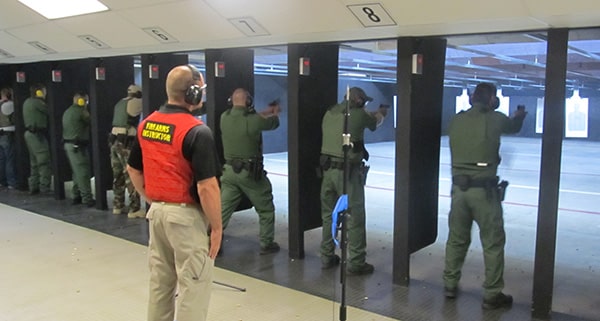
Here's a secret: Sustained noise at "safe" levels can still damage your hearing.
Each gunshot's sound wave lasts up to 5 milliseconds.
[25]
200 gunshots make 1 second of noise.
Pistol Shots until Hearing Loss
Practicing alone, you may go through 200 rounds. But in group practice or training, all the people around you will be firing, too.
Outdoors, some of that sound drops off with distance, but being indoors amplifies the sound (as much as 8x).
[17]
[18]
How do we account for that?
7 Best Hearing Protection for Shooting
- Shooting Earpro Calculator
- Best Ear Protection for Shooting
Shooting Earpro Calculator
The best hearing protection for shooting depends on how you shoot. Take out the guesswork from protecting your hearing and try our calculator:
Your Recommended Earpro
Best Deal Guarantee
Updated hourly
|
|
Walker's Razor Slim
$44.69
$39.59
@ 
Compare Prices
|
| NRR |
23 |
| Sound Type |
Mono |
| Sound Quality |
None |
| Comfort |
|
|
Low profile |
Your Recommended Earpro Combo
Best Deal Guarantee
Updated hourly
|
|
Walker's Razor Slim
$44.69
$39.59
@ 
Compare Prices
|
SureFire Sonic Defenders
$30.73
$17.99
@ 
Compare Prices
|
| NRR |
23 |
28 |
| Sound Type |
Mono |
|
| Sound Quality |
None |
|
| Comfort |
|
|
|
Low profile |
Adaptive protection only reduces noises over 85 dB |
Your Recommended Earpro
Best Deal Guarantee
Updated hourly
|
|
Howard Leight Impact Pro
$76.79
@ 
Compare Prices
|
| NRR |
30 |
| Sound Type |
Stereo |
| Sound Quality |
None |
| Comfort |
|
|
|
Your Recommended Earpro Combo
Best Deal Guarantee
Updated hourly
|
|
Howard Leight Impact Pro
$76.79
@ 
Compare Prices
|
SureFire Sonic Defenders
$30.73
$17.99
@ 
Compare Prices
|
| NRR |
30 |
28 |
| Sound Type |
Stereo |
|
| Sound Quality |
None |
|
| Comfort |
|
|
|
|
Adaptive protection only reduces noises over 85 dB |
Your Recommended Earpro
Best Deal Guarantee
Updated hourly
|
|
Peltor Sport Tactical 300
$151.89
@ 
Compare Prices
|
| NRR |
24-26 |
| Sound Type |
Stereo |
| Sound Quality |
|
| Comfort |
|
|
True NRR is 16 for speech and lower-frequency sounds, 21 for mid-frequency, and 31-39 for high frequency.
Gunshots are mid to high frequency. |
Your Recommended Earpro Combo
Best Deal Guarantee
Updated hourly
|
|
Peltor Sport Tactical 300
$151.89
@ 
Compare Prices
|
SureFire Sonic Defenders
$30.73
$17.99
@ 
Compare Prices
|
| NRR |
24-26 |
28 |
| Sound Type |
Stereo |
|
| Sound Quality |
|
|
| Comfort |
|
|
|
True NRR is 16 for speech and lower-frequency sounds, 21 for mid-frequency, and 31-39 for high frequency.
Gunshots are mid to high frequency. |
Adaptive protection only reduces noises over 85 dB |
Your Recommended Earpro
Best Deal Guarantee
Updated hourly
|
|
MSA Sordin Supreme Pro X
Check price
@ 
|
| NRR |
18 (21-28 for gunshots) |
| Sound Type |
Stereo |
| Sound Quality |
|
| Comfort |
|
|
True NRR is 16 for speech and lower-frequency sounds, 23 for mid-frequency, and 25-38 for high frequency.
Gunshots are mid to high frequency. |
Your Recommended Earpro Combo
Best Deal Guarantee
Updated hourly
|
|
MSA Sordin Supreme Pro X
Check price
@ 
|
Alpine MusicSafe Pro Earplugs
Check price
@ Amazon
|
| NRR |
18 (21-28 for gunshots) |
22 |
| Sound Type |
Stereo |
|
| Sound Quality |
|
|
| Comfort |
|
|
|
True NRR is 16 for speech and lower-frequency sounds, 23 for mid-frequency, and 25-38 for high frequency.
Gunshots are mid to high frequency. |
|
Your Recommended Earpro Combo
Best Deal Guarantee
Updated hourly
|
|
MSA Sordin Supreme Pro X
Check price
@ 
|
SureFire Sonic Defenders
$30.73
$17.99
@ 
Compare Prices
|
| NRR |
18 (21-28 for gunshots) |
28 |
| Sound Type |
Stereo |
|
| Sound Quality |
|
|
| Comfort |
|
|
|
True NRR is 16 for speech and lower-frequency sounds, 23 for mid-frequency, and 25-38 for high frequency.
Gunshots are mid to high frequency. |
Adaptive protection only reduces noises over 85 dB |
Your Recommended Earpro
Best Deal Guarantee
Updated hourly
Best Ear Protection for Shooting
If you'd rather browse, here's our roundup of the best ear protection for shooting.
Best Earmuffs for Shooting
As price goes up, sound quality goes up for electronic earmuffs. If you just want protection, you can go budget.
Best Electronic Earmuffs for $99 or less
Best Protection: Howard Leight Impact Pro
The Howard Leight Impact Pro offers:
-
Great protection.
-
Awesome battery life.
-
Stereo sound at okay quality.
It's an incredible value. What's the catch?
For some people, its bulk can get in the way when shooting a rifle or shotgun.
That can break the earmuff seal and degrade sound protection.
Best Budget Pick for Long Guns: Walker's Razor Slim
The Walker's Razor Slim offers a slim profile that's better for long guns.
You lose some hearing protection and mono sound for that. I highly recommend doubling-up with earplugs when shooting long guns with these.
Which is Best for Me?
If you only shoot pistols, get the Howard Leight.
Otherwise, the Walker's may be a better choice.
Just be sure to double-up with earplugs like the SureFire Sonic Defenders.
Best Deal Guarantee
Updated hourly
|
|
Walker's Razor Slim
$44.69
$39.59
@ 
Compare Prices
|
Howard Leight Impact Pro
$76.79
@ 
Compare Prices
|
| NRR |
23 |
30 |
| Sound Type |
Mono |
Stereo |
| Sound Quality |
None |
None |
| Comfort |
|
|
|
Low profile |
|
Best Electronic Earmuffs for $100-250
Most Protection: Peltor Sport Tactical 300
The Peltor Sport Tactical 300 seems like a great choice, with good NRR and great sound quality.
Only downside? The headband has no padding. No idea why. Wear a hat with this one.
Most Comfortable: MSA Sordin Supreme Pro X
The MSA Sordin Supreme Pro X may seem a worse choice, but beware: its NRR is deceptive.
It's built for little noise reduction from speech and lower-frequency sounds (NRR 16).
It maxes out noise reduction from gunshots (NRR 21-28).
Its average NRR of 18 seems low, but for shooters, it really isn't.
And its headband is much more comfy.
MSA Sordins have good aftermarket support. If the pads in the earmuffs break down, they're easy to replace or upgrade.
If you want more comfort, get the MSA Sordin. If you want more hearing protection, get the Peltor.
Best Deal Guarantee
Updated hourly
|
|
Peltor Sport Tactical 300
$151.89
@ 
Compare Prices
|
MSA Sordin Supreme Pro X
Check price
@ 
|
| NRR |
24-26 |
18 (21-28 for gunshots) |
| Sound Type |
Stereo |
Stereo |
| Sound Quality |
|
|
| Comfort |
|
|
|
True NRR is 16 for speech and lower-frequency sounds, 21 for mid-frequency, and 31-39 for high frequency.
Gunshots are mid to high frequency. |
True NRR is 16 for speech and lower-frequency sounds, 23 for mid-frequency, and 25-38 for high frequency.
Gunshots are mid to high frequency. |
Best Electronic Earmuffs for over $250
Best Money Can Buy: OPS-Core AMP with NFMI Earplugs
The OPS-Core AMP with NFMI Earplugs is the Holy Grail headset that special forces use.
Why? Combining most earplugs and muffs costs you some sound quality and directional hearing.
Special forces need to sneak around and detect enemies, so that doesn't work.
The OPS-Core AMP earmuffs and NMFI earplugs work together as a system.
They give top sound quality, directional hearing, and max protection.
It enhances your hearing while protecting it.
It's the ultimate in hearing protection.
Best Earplugs for Shooting
Best Non-Electronic: SureFire Sonic Defenders
If you have electronic earmuffs, use the SureFire Sonic Defenders for max hearing protection.
They can also be worn for more regular use. They have a plunger you can open up.
When you do, the overall hearing protection is reduced, but it will only protect against sounds louder than 85 dB.
That means you can still hear talking and other stuff you want to hear.
Need full protection? Close the plunger.
These are comfortable, versatile, and a great value. I carry them on me all the time.
Best Electronic: Peltor TEP-100s
If you want electronic hearing protection you can carry in a pocket, these are a good pick.
I prefer the SureFire Sonic Defenders with electronic earmuffs, but the Peltor TEP-100s may fill a niche you need.
Best Deal Guarantee
Updated hourly
|
|
SureFire Sonic Defenders
$30.73
$17.99
@ 
Compare Prices
|
3M Peltor TEP-100
$
$9999.99
@ 
Compare Prices
|
| NRR |
28 |
23 |
| Sound Quality |
|
|
|
Adaptive protection only reduces noises over 85 dB |
Electronic earplugs. Protection and awareness at max convenience. |
Disclaimer: As an Amazon Associate I earn from qualifying purchases, at no extra cost to you.
Related Articles
Feedback
Are you happy with this page?
References
-
What Noises Cause Hearing Loss? (2019)
-
Protecting your hearing (2019)
-
Degradation of front-back spectral cues inducedby tactical communication and protective systems (2015)
-
Performance Assessment of Passive Hearing Protection Devices (2014)
-
Performance Assessment of Communication Enhancement Devices: TEA HI Threat Headset (2015)
-
Performance Assessment of the OTTO Hurricane with Invisio V60 and Sonic Defenders EP4 (2015)
-
Hearing protection devices and methods used for their evaluation: A military perspective (2019)
-
Better Protection From Blasts Without Sacrificing Situational Awareness (2011)
-
How to Use the Noise Reduction Rating (NRR) (2011)
-
Comparison of different types of hearing protection devices for use during weapons firing (2015)
-
Efficiency of Attenuating High-Level Acoustic Impulses with Double Protection (Earplugs and Earmuffs Used Simultaneously) (2006)
-
Attenuation performance of double hearing protection devices (2010)
-
Auditory Levels of Sport Firearms (2012)
-
Selection of Level-Dependent Hearing Protectors for Use in An Indoor Shooting Range (2019)
-
Bone Conducted Noise and Mitigation Techniques (2009)
-
Hearing Protection for Bone-Conducted Sound (2005)
-
A Primer on Indoor Shooting Range Acoustics (2012)
-
Estimating Sound Levels With the Inverse Square Law (2007)
-
Sound Distance Attenuation Calculator (2019)
-
Electronic Ear Muff Recommendations (2016)
-
Auditory risk estimates for youth target shooting. (2014)
-
Auditory Risk to Unprotected Bystanders Exposed to Firearm Noise (2011)
-
Estimates of auditory risk from outdoor impulse noise. II: Civilian firearms. (2009)
-
Assessment of Noise Exposure for Indoor and Outdoor Firing Ranges (2007)
-
Summary of Gun Shot Acoustics (2006)
-
Physical Characteristics of Gunfire Impulse Noise and Its Attenuation by Hearing Protectors (1995)
-
High Level Impulse Sounds and Human Hearing: Standards, Physiology, Quantification (2012)